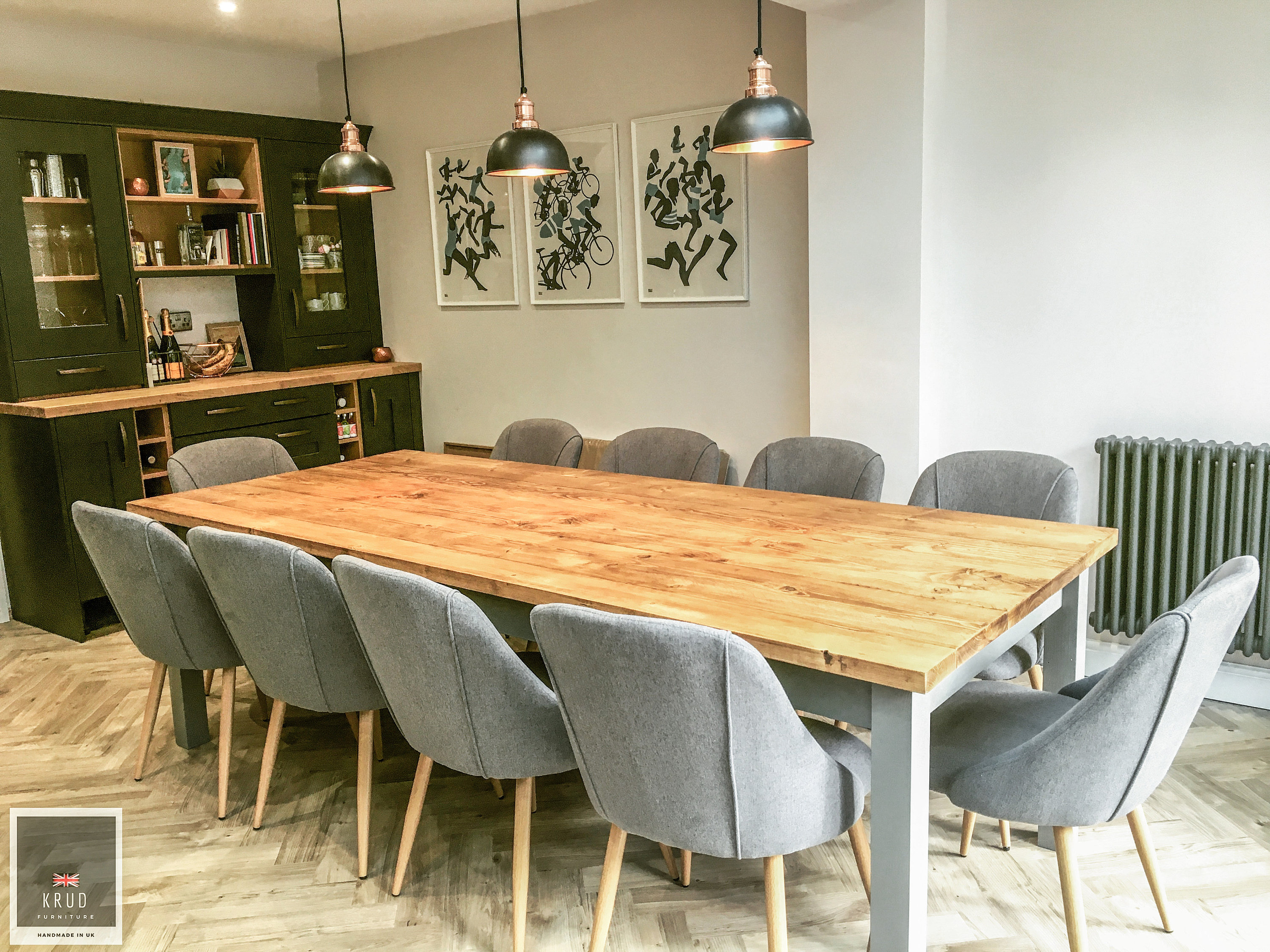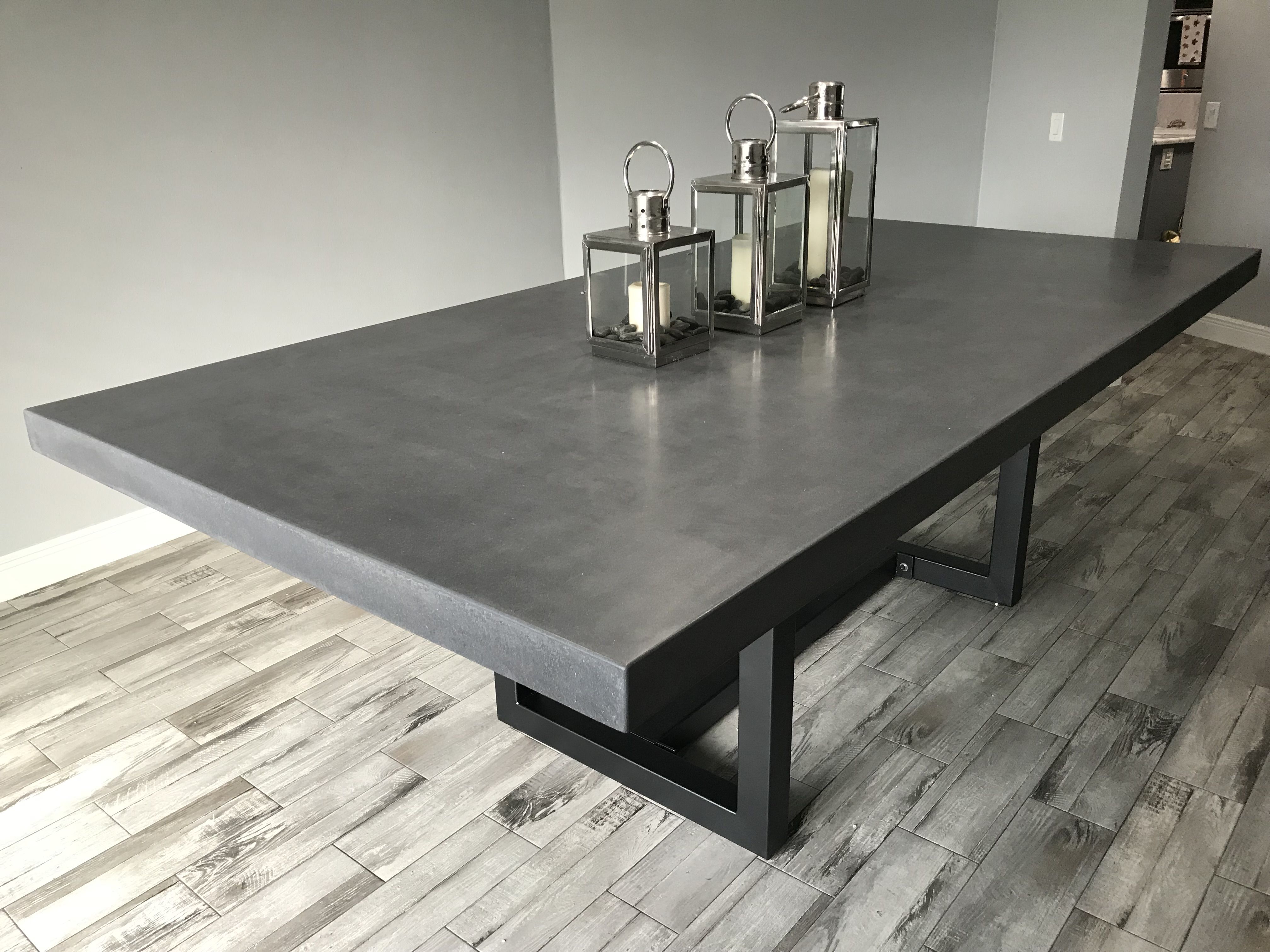Finding the Perfect 10-Chair Dining Table

Choosing the right dining table for ten people is a significant undertaking, impacting both the functionality and aesthetic of your dining space. Consider your lifestyle, available space, and desired ambiance to ensure a harmonious blend of form and function. This guide explores key aspects to help you make an informed decision.
Design Styles for 10-Chair Dining Tables
The style of your dining table significantly influences the overall feel of your dining room. Choosing the right style complements your existing décor and reflects your personal taste.
| Style | Materials | Finishes | Example |
|---|---|---|---|
| Traditional | Solid wood (oak, mahogany), marble | Polished, stained, lacquered | A large, rectangular table with intricately carved legs and a dark, polished finish. |
| Modern | Glass, metal, high-pressure laminate | Clear, matte, powder-coated | A sleek, rectangular table with a minimalist design and a chrome metal base. |
| Farmhouse | Reclaimed wood, metal | Distressed, painted, natural | A long, rectangular table with a rustic wood top and metal legs, possibly with a slightly distressed finish. |
| Contemporary | Wood veneer, concrete, stainless steel | High-gloss, brushed, polished concrete | A circular or oval table with a clean, simple design and a high-gloss finish. |
| Mid-Century Modern | Teak, walnut, chrome | Natural wood tones, polished chrome | A table with tapered legs and a simple, geometric design, often featuring a wood top and metal base. |
Table Shapes for Ten-Person Seating
The shape of your dining table impacts seating arrangement, conversation flow, and the overall dynamics of your dining area. Each shape offers unique advantages and disadvantages.
Choosing the right shape depends heavily on the available space and your preferred seating arrangement.
- Round Tables:
- Advantages: Promotes conversation and a sense of community; good for smaller spaces due to its compact nature; aesthetically pleasing.
- Disadvantages: Can be difficult to accommodate ten people comfortably without feeling cramped; may not be suitable for formal settings.
- Rectangular Tables:
- Advantages: Easily accommodates large groups; ideal for formal dinners; offers ample space for serving dishes.
- Disadvantages: Can feel less intimate for conversation; may not be suitable for smaller spaces.
- Oval Tables:
- Advantages: Combines the intimacy of a round table with the space of a rectangular one; good for larger spaces; elegant and sophisticated.
- Disadvantages: Can be more expensive than other shapes; may require more space than a round table.
- Square Tables:
- Advantages: Efficient use of space; suitable for smaller rooms; easy to arrange seating.
- Disadvantages: May not be ideal for large groups; can feel cramped for ten people; less versatile than other shapes.
Price Ranges for 10-Chair Dining Tables
The cost of a 10-chair dining table varies significantly based on materials, design, and brand. Understanding the different price points and their associated features can guide your purchasing decision.
| Price Range | Materials | Features | Example |
|---|---|---|---|
| Budget (<$1000) | Manufactured wood, laminate | Simple design, basic construction | A rectangular table made of particleboard with a laminate finish. |
| Mid-Range ($1000-$3000) | Solid wood (pine, rubberwood), veneer | More elaborate design, sturdier construction, potentially some detailing | A rectangular or oval table made of solid rubberwood with a slightly more ornate design. |
| High-End (>$3000) | Solid hardwood (oak, cherry, walnut), marble, glass | Intricate design, high-quality materials, superior craftsmanship | A large, oval table made of solid walnut with a marble inlay and intricately carved legs. |
Modern Minimalist 10-Chair Dining Table, 10 chair dining table
Imagine a sleek, rectangular table crafted from light oak wood with a natural, oiled finish. The minimalist design features clean lines and a simple, uncluttered aesthetic. The legs are slender and subtly tapered, supporting the expansive tabletop. The overall color palette is neutral and calming, with the light oak complemented by crisp white chairs. The overall effect is one of understated elegance and sophistication, creating a tranquil and inviting dining space.
Space Planning & Functionality: 10 Chair Dining Table

Accommodating a 10-chair dining table requires careful planning to ensure both comfort and efficient use of space. A poorly planned placement can lead to cramped walkways and an overall feeling of discomfort, undermining the intended social function of the dining area. This section provides a practical guide to effectively integrating a large dining table into your home.
Measuring Your Dining Space
Determining the ideal size and shape of your 10-chair dining table begins with accurate measurements of your dining space. This involves more than just the floor area; it also considers the available space for comfortable chair movement and access. Follow these steps:
- Measure the length and width of your dining area: Use a measuring tape to accurately determine the dimensions of the space allocated for your dining table and chairs. Note any obstructions like doorways, radiators, or architectural features.
- Determine the minimum walkway space: Allow at least 36 inches (91 cm) of clear space around the table for comfortable chair movement and walking. This ensures guests can easily pull out their chairs and move around the table without feeling restricted. Consider wider walkways if your dining area is used frequently.
- Visualize chair placement: Sketch a simple floor plan of your dining area, noting the dimensions. Draw in the table and chairs to scale, ensuring that the minimum walkway space is maintained. This helps visualize potential space issues before purchasing a table.
- Consider the table shape: Rectangular tables are ideal for linear spaces, while round or oval tables are better suited for spaces where people need to interact more easily. A square table might be suitable for a smaller area.
10 chair dining table – Diagram Example: Imagine a rectangular dining area measuring 15ft x 12ft. A 10-foot rectangular table with 36 inches of walkway space on each side would require a minimum of 10 feet x 10 feet, leaving some space at the ends. A circular table of similar capacity might need a slightly larger area to accommodate the curvature and chair placement.
Table Extension Mechanisms
The choice of table extension mechanism significantly impacts functionality, especially in spaces with varying needs. Consider these options:
- Leaf Extension: These tables have removable leaves stored separately, offering flexibility. They are suitable for smaller spaces where extra seating is only needed occasionally. However, storage for the leaves needs to be considered.
- Butterfly Extension: These tables feature built-in leaves that fold out from the center, offering a seamless transition between sizes. They are convenient and space-saving, ideal for spaces with limited storage.
- Drop-Leaf Extension: These tables have leaves that drop down from the sides, providing extra seating space when needed. They are best suited for smaller spaces and situations where a large table is needed only intermittently.
Furniture Arrangement Strategies
Optimizing space around a large dining table requires careful consideration of chair placement and traffic flow. The following table compares different arrangements:
| Arrangement | Pros | Cons | Suitable for |
|---|---|---|---|
| Standard (all chairs around the table) | Simple, maximizes seating | Can restrict movement if space is tight | Larger dining areas |
| Against the wall (some chairs against a wall) | Saves space, allows for more open floor area | Reduces interaction between seated guests | Smaller dining areas, or open-plan spaces |
| L-shaped arrangement (table placed in a corner) | Space-saving, creates a defined dining zone | May limit seating capacity, less ideal for larger gatherings | Corner spaces, smaller dining areas |
| Island arrangement (table in the center of the room) | Promotes interaction, creates a focal point | Requires significant space | Large open-plan spaces |
Incorporating a 10-Chair Table into Open-Plan Living Spaces
Integrating a 10-chair dining table into an open-plan living space requires a holistic approach. Consider using area rugs to define the dining zone, separating it visually from the living area. Choose furniture that complements the style of the dining table and maintains a cohesive look. For instance, a modern dining table might pair well with minimalist seating and a sleek sideboard. A rustic table could be complemented by farmhouse-style chairs and a distressed wooden buffet. Maintaining a consistent color palette throughout the open-plan space will further enhance the visual integration. Remember to ensure sufficient space for comfortable movement between the dining and living areas.
Materials, Maintenance & Longevity

Choosing the right materials for your 10-chair dining table is crucial for its lifespan and aesthetic appeal. The material you select will directly impact not only the table’s durability but also its maintenance needs and overall cost. Let’s delve into the specifics of three popular choices: wood, metal, and glass.
Wood Table Durability, Maintenance, and Cost
Wood offers timeless elegance and warmth. However, different wood types vary significantly in hardness and durability. Hardwoods like oak and mahogany are more resistant to scratches and dents than softer woods like pine. Proper care is essential to maintain their beauty.
- Pros: Natural beauty, wide range of styles, can be refinished, relatively easy to repair minor damage.
- Cons: Susceptible to scratches, water damage, and temperature fluctuations; requires regular maintenance; higher initial cost compared to metal or glass.
Metal Table Durability, Maintenance, and Cost
Metal dining tables, often made from steel or wrought iron, offer a modern and industrial aesthetic. They are generally durable and resistant to scratches and dents, but can be susceptible to rust if not properly maintained.
- Pros: Durable, resistant to scratches and dents, relatively easy to clean, often more affordable than wood.
- Cons: Can be prone to rust or corrosion, may feel cold to the touch, can be heavy and difficult to move.
Glass Table Durability, Maintenance, and Cost
Glass dining tables provide a sleek and contemporary look. However, they are more susceptible to chipping and shattering than wood or metal. Tempered glass is significantly stronger and safer than regular glass.
- Pros: Sleek and modern appearance, easy to clean, resistant to stains and moisture.
- Cons: Susceptible to chipping and shattering, can be prone to scratches, requires careful handling.
Cleaning and Maintaining Different Dining Table Materials
Proper cleaning and maintenance are vital for extending the life of your dining table. Different materials require different approaches. Ignoring these steps can lead to irreversible damage.
| Material | Cleaning Method | Maintenance Tips | Common Mistakes to Avoid |
|---|---|---|---|
| Wood | Dust regularly with a soft cloth. Wipe spills immediately. Use a wood cleaner specifically designed for your finish. | Apply a protective coat of wax or oil periodically. Avoid placing hot items directly on the surface. Use coasters. | Using harsh chemicals, leaving spills to dry, using abrasive cleaners. |
| Metal | Wipe with a damp cloth and mild detergent. Dry thoroughly. | Apply a protective sealant or wax to prevent rust. Avoid using abrasive cleaners. | Using harsh chemicals, neglecting to dry completely, allowing rust to develop. |
| Glass | Wipe with a glass cleaner and a soft cloth. Avoid abrasive cleaners. | Use coasters to protect the surface from scratches. Handle with care to prevent chipping or shattering. | Using abrasive cleaners, placing hot items directly on the surface, using harsh chemicals. |
Impact of Finishes on Longevity and Appearance
The finish applied to your dining table significantly impacts its longevity and aesthetic appeal. A high-quality finish protects the wood from scratches, moisture, and stains, extending its life.
Lacquer provides a hard, durable finish that is resistant to scratches and water damage. Varnish offers similar protection but may yellow over time. Stain penetrates the wood, enhancing its natural color and grain, but offers less protection than lacquer or varnish. The choice depends on your desired look and level of protection. For example, a high-traffic household might benefit from a durable lacquer finish, while a more rustic aesthetic might favor a stain.
